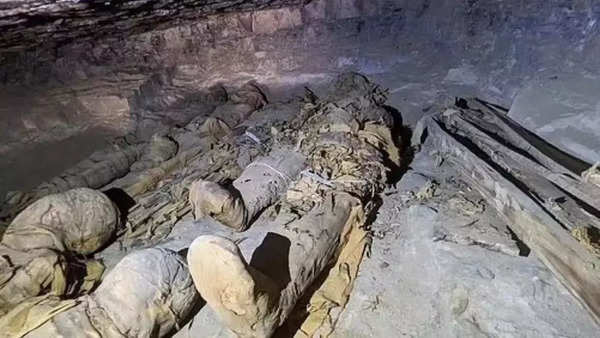Trending
All about the 'City of the Dead' where archaeologists have unearthed 1000 mummies
Archaeologists in Aswan, Egypt, have unearthed a vast "City of the Dead" containing over 1000 mummies in more than 300 tombs. Dating back from the 6th century B.C. to the 9th century A.D., this discovery provides insights into ancient burial practices and social hierarchies. The site's well-preserved artifacts, including infant mummies and funeral gifts, highlight the harsh living conditions and health challenges faced by ancient Egyptians. This find underscores ongoing efforts to preserve and study Egypt's rich archaeological heritage.

A stunning discovery by archaeologists at Aswan in Egypt has revealed over 300 tombs containing 1000 mummies. Source: Ministry of Tourism and Antiquities
Archaeologists have made a groundbreaking discovery in Aswan, Egypt, unearthing a “City of the Dead” that contains thousands of mummies. This significant find is located near the Mausoleum of Aga Khan III and marks the culmination of five years of meticulous excavation work. The site, which spans approximately 270,000 square feet, includes over 300 tombs, each housing between 30 to 40 mummies.This discovery provides a fascinating glimpse into the burial practices and social dynamics of ancient Egyptian society.
The excavation team, led by Patrizia Piacentini from the University of Milan, began their work in 2019. The site dates back to a period between the 6th century B.C. and the 9th century A.D., a span of roughly 900 years. Aswan, known as Swenett in ancient times, was a crucial military post and trade hub, strategically located at the base of the Nile River. That the city was important in its time is proven by its vast granite quarry and its role as a crossing point for people and goods from various regions.
The tombs discovered at the site are arranged in terraces, reflecting the social hierarchy of the time. The elite were buried at the top of the hill, while the middle class and lower classes were interred in tombs further down. Among the notable finds is the well-preserved mummy of a general in chief of Aswan, highlighting the importance of the individuals buried at this site. Many of the tombs contained funeral gifts such as pottery, wood carvings, and other artifacts, providing valuable insights into the customs and beliefs of the ancient Egyptians.
One of the most striking aspects of this discovery is the high number of infant and child mummies. Ayman Ashmawy, head of the Egyptian Antiquities Sector, noted that studies conducted on the remains suggest that roughly 30 to 40 percent of those buried at the site were young adults or infants who succumbed to diseases such as tuberculosis, anemia, and organ disease. This high mortality rate among children displays the harsh living conditions and health challenges faced by the ancient population. Some of the mummies were found wrapped in cartonnage, a type of paper mache material, indicating the care and effort put into the burial process.

Patrizia Piacentini, the mission’s Italian director, described the find as “really spectacular, very unique in Egypt.” She added, "The people who once lived in Aswan covered the hill with tombs. It is kind of a City of the Dead".
The Ministry of Tourism and Antiquities in Egypt has played a crucial role in supporting the excavation and preservation efforts. The ministry’s involvement ensures that the discoveries are protected and made accessible to the public. Aswan's "City of the Dead" is a stunning example of ancient Egypt's rich history and cultural heritage. This discovery not only improves our understanding of ancient Egyptian civilization, but it also emphasizes the need of continuing archaeological study in unearthing the mysteries of the past.
The excavation team, led by Patrizia Piacentini from the University of Milan, began their work in 2019. The site dates back to a period between the 6th century B.C. and the 9th century A.D., a span of roughly 900 years. Aswan, known as Swenett in ancient times, was a crucial military post and trade hub, strategically located at the base of the Nile River. That the city was important in its time is proven by its vast granite quarry and its role as a crossing point for people and goods from various regions.
The tombs discovered at the site are arranged in terraces, reflecting the social hierarchy of the time. The elite were buried at the top of the hill, while the middle class and lower classes were interred in tombs further down. Among the notable finds is the well-preserved mummy of a general in chief of Aswan, highlighting the importance of the individuals buried at this site. Many of the tombs contained funeral gifts such as pottery, wood carvings, and other artifacts, providing valuable insights into the customs and beliefs of the ancient Egyptians.
One of the most striking aspects of this discovery is the high number of infant and child mummies. Ayman Ashmawy, head of the Egyptian Antiquities Sector, noted that studies conducted on the remains suggest that roughly 30 to 40 percent of those buried at the site were young adults or infants who succumbed to diseases such as tuberculosis, anemia, and organ disease. This high mortality rate among children displays the harsh living conditions and health challenges faced by the ancient population. Some of the mummies were found wrapped in cartonnage, a type of paper mache material, indicating the care and effort put into the burial process.
The discovery of the “City of the Dead” has also shed light on the reuse of tombs over centuries. Many of the tombs were used repeatedly, with new burials placed on top of older ones. This practice shows the evolving burial customs and the continuous use of the site by successive generations. The excavation team has taken great care to document and preserve the findings, with the most well-preserved mummies being sent to various museums for further study and exhibition.

The site showed that burial practices involved reusage of tombs over several centuries. Source: Ministry of Tourism and Antiquties.
Patrizia Piacentini, the mission’s Italian director, described the find as “really spectacular, very unique in Egypt.” She added, "The people who once lived in Aswan covered the hill with tombs. It is kind of a City of the Dead".
The Ministry of Tourism and Antiquities in Egypt has played a crucial role in supporting the excavation and preservation efforts. The ministry’s involvement ensures that the discoveries are protected and made accessible to the public. Aswan's "City of the Dead" is a stunning example of ancient Egypt's rich history and cultural heritage. This discovery not only improves our understanding of ancient Egyptian civilization, but it also emphasizes the need of continuing archaeological study in unearthing the mysteries of the past.
Watch: Indian Rafaels' Stunning Show Around Egyptian Pyramids
End of Article
FOLLOW US ON SOCIAL MEDIA










